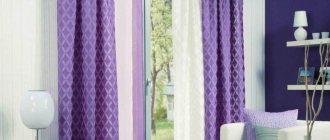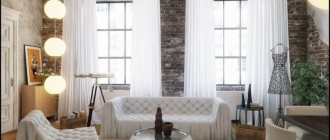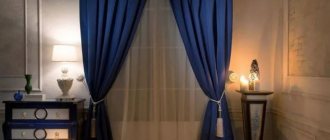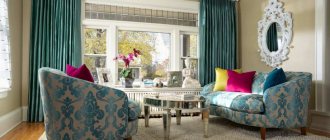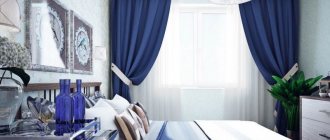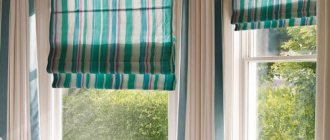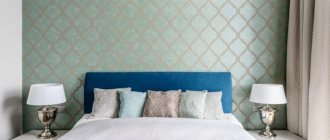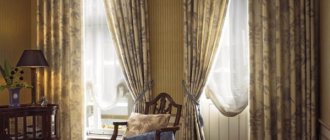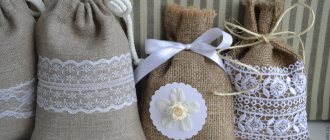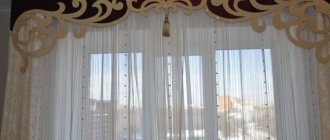Content
- Japanese curtains: description
- How to choose fabric for Japanese curtain panels?
- Advantages of panel light protection systems
- Application options for Japanese curtains:
- Screens in the living room and bedroom
- Panel systems for office premises
- Japanese curtains for the kitchen
Fans of non-standard design of light openings will appreciate the discreet beauty of Japanese (panel) curtains. These light-protective systems, when selected correctly, look great in any interior. The exception is narrow windows, where such products cannot reveal aesthetic and functional qualities. Initially, panel systems were used as sliding panels, with the help of which in Japan rooms were zoned into compartments for different functional purposes. In Europe, their functionality has been significantly expanded. Now the panels are used as window curtains, doors, screens, and mobile partitions.
Features and characteristics of Japanese curtains
Laconic, harmoniously fitting into the interior, stylish, original - all these characteristics belong to curtains designed in the Japanese style. Other names for such products are curtain panels, curtain screens, since they are sliding structures.
Initially, such products were intended to divide a large room into separate zones. Using them as window curtains became a European idea.
Japanese curtains are straight pieces of fabric, approximately one and a half meters wide. They consist of two elements that move sideways using installed fixed guides. With their mechanism they resemble vertical blinds or a wardrobe.
- 1 Features and characteristics of Japanese curtains
- 2 Advantages and disadvantages
- 3 In what interiors are they used?
- 4 Mounting methods
- 5 Japanese screen curtains in the kitchen interior
- 6 Panel curtains for the living room
Thin and light fabric is tightly stretched over the frame to avoid wrinkles, because the fabric for Japanese curtains must be perfectly smooth. Dense fabrics simply become heavier at the bottom. Cornices with canvas are attached to the floor, walls, ceiling, doorway.
Japanese curtains: description
These systems are vertically arranged rectangular pieces of fabric, attached to a frame or weighted at the bottom. The width of the panels does not exceed 1.5 m, usually it is 0.4-0.8 m. Screen curtains are somewhat reminiscent in design of vertical blinds, which do not have a rotation function. Japanese panels are usually made as laconic as possible. Fringe, frills, lambrequins, bows are not welcome.
To install curtains on the ceiling, wall, or window opening, special cornices are used, along which the panels move, closing and opening the light opening. Cornices can reach 8 m. Long models are usually used when zoning rooms. Most often, curtain rods are mounted in shorter lengths, this is especially true for heavy fabrics. In systems consisting of several canvases, the screens can move along several tracks of the cornice or one at a time. In the latter case, the fabric strips form one wide screen. With the help of multi-track curtain rods, you can radically change the design of the room by arranging the curtains in the desired order.
We sew curtains ourselves
There's nothing complicated about it. Fabrics are presented in stores in a wide range. You can even find already cut canvases with traditional Japanese ornaments and subjects. The necessary accessories are sold at any hardware store.
Japanese curtains - we sew them ourselves:
- Calculate how much fabric you need, based on the fact that the average width of one panel is 60 cm. If you want them to overlap each other, add an additional 60 cm. Length - the distance from the cornice to the floor plus 10 cm on each side for allowances .
- Cut the fabric into strips of the required width, taking into account the side allowances (3-4 cm on each side). Make the seams on the sides first. If the fabric is thin, plastic or fiberglass strips are inserted into them to create a rigid frame. Additionally, seal the seams with non-woven fabric or Velcro tape, otherwise the edge will not be perfectly smooth. Iron thoroughly.
- There is a drawstring at the bottom to insert the weighting material, and Velcro at the top. Be sure to iron it before sewing. Carefully secure with pins or freehand stitches at the edge of the top cut and machine sew the seam. Fold it inside out and stitch it too.
- Iron the resulting fabric so that it does not sag anywhere and wrinkles do not form.
- Hang the curtains on the curtain rod and thread the weights into the drawstring.
Article on the topic: Stylish and cozy curtains for the hall (+40 photos)
Video gallery
Photo gallery
How to choose fabric for Japanese curtain panels?
Fabrics traditional for oriental style are natural, linen or cotton. In addition to being environmentally friendly, their advantage is their reluctance to attract dust due to the electrification effect. Modern systems often use beautiful, practical, easy-to-care materials made from mixed fibers. Straw and bamboo fabrics and thick rice paper are in demand.
The density of the panels may vary. However, dense linen, cotton, and silk satin screens retain their shape best. According to the level of light transmission, the strips can be opaque, translucent, or transparent. Systems that combine panels of dense fabrics with translucent and transparent screens made of moire, organza, and chiffon look impressive.
Colors - plain, striped, with floral or geometric patterns, patterns. Color solutions are very different, depending on the size of the room, the sides on which the windows face, and the functional purpose of the room. The most popular pastel shades are beige, yellow, and pink. Pink panels go well with gray screens. Lighting fixtures and bright interior accessories look impressive against the background of such systems.
When choosing fabric, take into account the characteristics of the room:
- Light translucent and transparent fabrics are suitable for dark rooms.
- In rooms with windows facing the sunny side, dense materials are usually used.
- Screen curtains are an excellent choice for large rooms with panoramic windows. The height of the panels in such cases is usually equal to the height of the room.
In what interior style are curtain panels appropriate?
Original Japanese-style curtains are used not only for interiors with Japanese minimalism. This form is suitable for zoning and decorating windows in different styles. It all depends on decorative purposes and the choice of textiles.
1. Eco-style (fabrics with imitation textures of natural materials).
2. Loft (full with complex print, collage).
3. Decoration (smooth translucent screens, imitation of the “absence” of curtains).
4. Gothic (stained glass type partitions).
5. Ethnics (any ornament based on folk motifs).
6. High-tech (fabrics with a metallic sheen in LED lighting).
7. Avant-garde (original drawing, abstraction, you can do it yourself).
8. Art Deco (unusual colors that replace paintings).
9. Fusion (any eclecticism is acceptable within the framework of the general idea).
10. Expressionism (expressive drawing in bright colors).
Screened Japanese curtains are appropriate in the interior of any room, even in the bathroom, if you use washable materials. They will favorably highlight the author's interior design in the living room and bedroom.
This decor is suitable for zoning studio apartments and loft apartments. Even more ideas are in our illustrations.
We also recommend watching:
- Double curtains
- Striped curtains
- Burgundy curtains
- Patterned curtains
- Magnetic curtains
- Light green curtains
- Curtains for wallpaper
- Zebra curtains
- Orange curtains
- Curtains for the balcony
- Curtain design for the kitchen
- White curtains
- Curtains for the living room
- Blue curtains
- Pink curtains
- Lilac curtains
- Blackout curtains
- Golden curtains
Advantages of panel light protection systems
The popularity of curtain screens is explained by a combination of aesthetic and practical characteristics, including:
- The ability to choose the fabric that is most suitable in color, texture, and light transmittance.
- Easy to care for. There is no need to iron folds or ruffles, and dust and dirt do not accumulate in draperies. If the panels are attached to the curtain rod with Velcro, then they can be easily removed, washed and hung in place.
- Small amount of fabric required to create systems and ease of sewing.
- Easy to install and dismantle.
- Convenient to use. By moving the screens of a single or multi-layer system, you can easily and quickly change the atmosphere in the room.
Why are Japanese curtains convenient?
Japanese curtains have a number of undoubted advantages. They practically do not absorb dust and are very easy to care for. Simply remove them from the frames and wash them.
Despite the apparent simplicity and pronounced minimalism of the design, such curtains can still give scope to the imagination of their owners. For example, it is not necessary to have the same fabric in each panel. You can alternate fabrics of different colors, shades, textures.
Plain fabrics, fabrics with patterns - all this goes well with the design principle of Japanese curtains. It is quite possible to use panels of different widths or different mounting options to the wall or ceiling.
Application options for Japanese curtains
Panel light-protection systems look impressive on large, wide window openings in large rooms. It is not recommended to install screens on narrow windows, since such openings are visually perceived as narrower. Depending on the design task, curtains can serve as a bright accent or completely fit into the surrounding space.
Did you like the curtains? You can order the same in the Japanese curtains section
Screens in the living room and bedroom
In the living room and bedroom, panels can cover not only the windows, but also the door leading to the balcony. If it is necessary to create complete blackout and there is no desire to use dense panels, Japanese-style screens are combined with roller fabric curtains of the “Mini” system. Roller blinds with a light-proof blackout panel can completely block light from entering the room and create almost complete darkness on a bright sunny day. Panels intended for bedrooms should be dim, plain or with a discreet pattern.
For large living rooms, decorated in ethnic or urban styles, panels with bright prints - large flowers, rural or urban landscapes, birds - are suitable. For interiors in the minimalist style, screens chosen are single-color, with medium-sized geometric shapes, and discreet plant prints. In rooms made in Japanese style, the panels can depict hieroglyphs, birds, dragons, cherry blossoms, and landscapes painted in ink on a plain fabric.
Panel systems for office premises
Japanese curtains, thanks to their laconic form and ease of care, look great in a business office setting. An additional advantage is that if a panel breaks down, which is quite likely in a public building, it can be easily replaced with another one. Also, by replacing individual screens, you can radically change the office design.
Japanese curtains for the kitchen
For this room, plain panels or screens with a soft print are recommended. The best color solutions are shades of green, brown, and the colors of fallen leaves. Blended fabrics that combine natural and synthetic fibers are suitable for kitchen spaces, as they are easier to care for than natural materials. You can choose products with a bamboo panel.
For large rooms, screens with a height from floor to ceiling are usually chosen, for small rooms - from the ceiling to the window sill.
Interior style for curtains
Japanese curtains, in addition to being necessary in a traditional Japanese interior, act as an expressive detail in an interior in the style of hi-tech, avant-garde and minimalism. While emphasizing functionality, they add elegance without making the space feel cluttered.
The simplicity of Japanese style in the interior is only an appearance. You need to carefully think through everything and correctly place accents, achieving such laconicism and expressiveness, elegant asceticism.
In this case, it is better to entrust the design of the home to a professional designer. Everything should be in the same style. Japanese curtains, as an interesting detail, are suitable for anyone who wants to add originality and exoticism to their decor without much effort and expense, or simply to hide something from prying eyes. Line up several panels in a ladder or in one row, collect them on one side or place them on both sides of the window, or hide everything behind one of them. Japanese curtains look especially good in spacious rooms with large windows. It is better not to hang one panel on narrow windows - visually they will seem even smaller.
Remove massive furniture with many drawers, shelves and other unnecessary details from the room with Japanese curtains.
If you need to close a niche or fence off part of the space, it is difficult to find a better solution than Japanese curtains. In a one-room apartment, the only room can be divided into a living room and a bedroom. In the nursery, allocate space for sleeping, playing and studying. In the bedroom - fence off something like a boudoir. The kitchen is divided into a “dining room” and a cooking area. As for the kitchen, it is difficult to find an interior to which such curtains would not fit. Their practicality and simplicity will come in handy there.
Related article: Window decoration in the hall: recommendations for choosing tulle
In the bedroom, two or three panel curtains in pastel colors, in harmony with each other, would be appropriate. One of them can depict a traditional Japanese landscape. It is believed that thoughtful contemplation brings calm and leads to inner harmony. In addition, if you have insomnia, counting sakura flowers or flying geese is much more interesting than rams jumping over a fence.
For the kitchen, flashy prints, sharp contrasts, and bright colors are undesirable. Japanese culinary tradition dictates complete concentration on the process of preparing dishes and eating food.
You can combine several screens from light and dense fabrics or use smooth and textured material. Even better for the kitchen are natural materials - bamboo and straw. Since most often kitchens do not differ in size, the optimal length is up to the window sill. For a spacious kitchen with a large window, you might want to consider floor-length panels.
In the kitchen, unlike other rooms, choose curtain material made from synthetic fabrics. It is easier to remove stains from them, grease, odors, and cooking steam are less absorbed.
You can't go wrong by choosing colors found in nature in your kitchen - moss, peat, fallen leaves, stone. For a child's room, colorful curtains of fabric in cheerful shades, combined with bright plain fabrics, are suitable. For the living room, consider combining Japanese curtain panels with traditional draperies and tulle. You can completely cover not only the window, but also the entire wall where it is located.
Japanese curtains as movable partitions
Japanese curtains are an excellent option for rooms with unsightly nooks and crannies in which hangers, shelves, and niches are “hidden.” Using mobile panels, you can divide the studio into zones - bedroom, dining room, living room, kitchen. For curtains separating the bedroom, choose fabrics in delicate pastel shades, plain or with a romantic pattern or photo. In the bedroom itself, a curtain is used to separate out what looks like a boudoir.
The screen can be installed in a children's room to separate learning and play areas. For a nursery where a teenager lives, choose panels with bright prints applied using thermal printing.
When making screens intended for zoning rooms or masking unsightly parts of a room, dense, opaque fabrics that are resistant to deformation are usually used.
Interesting options for using curtains as partitions for a room - photo
When zoning a room with a Japanese curtain, panels of one or two colors are often used. Their density should be selected based on the illumination of the room, the location of the windows and the functional purpose of this decorative interior detail.
Similar news:
- Curtains for the kitchen photo 2020 - modern models
- Curtains for the kitchen 2020 - photos of new items, models, ideas, design
- How to choose a curtain rod: types and materials
- Curtains for the kitchen. Photos of 2020 modern models.
- Curtains for the living room - 100 photo options
- Choose beautiful curtains for a living room with a balcony
What interior styles are Japanese panel curtains suitable for?
Panel light-protection systems or screens used as mobile screens are perfect not only for Japanese-style rooms, but also for interiors in other style solutions:
- High tech . Materials with a metallic sheen or resembling plastic and frosted glass are used.
- Minimalism . Rectangular or square panels fit perfectly into rooms of this style. The color scheme is usually monochromatic. You can combine several plain panels of different colors.
- Vanguard . Screens with original asymmetrical patterns are suitable for this case.
- Eco . The panels are usually made from natural materials - coarse flax, cotton, rice paper, bamboo, straw.
The panels can be installed in one row, in a “ladder”, located on one or both sides of the window or door.
Panel curtains for the living room
Curtains for a living room in an oriental style look harmonious in combination with traditional curtains or tulle. With such a design solution, it is important that all elements are harmoniously combined with each other. You can decorate the window with Japanese blinds made of lightweight materials - chiffon, silk, organza, tulle, and complement them with curtains made of practical linen, satin, cotton or reaper.
Both plain and multi-colored screen curtains are suitable for the living room. You can decorate the window with curtains with beautiful prints. Large flowers, stripes, geometric shapes, abstraction, animal and plant motifs always remain relevant. The prints are suitable for interiors designed in a minimalist style.
When using panel curtains when designing a room, it is important to avoid massive furniture and items with many drawers and cabinets. You should know that this type of curtains is not suitable for rooms that are distinguished by pomp, brightness, a lot of decor, and the presence of gilding on pieces of furniture. With such luxury, the laconicism and restraint of Japanese curtains will be inappropriate.
Curtains made in Japanese style are an interesting piece of furniture that will find admirers among those who love simplicity and severity of forms.
Types of curtain rods for Japanese curtains
Cornices are special devices mounted on the ceiling, floor or wall. They may have a different number of guides.
Design options for cornices for Japanese curtains:
- Double row . The simplest option, suitable for both windows and partitions. The panels can move along different tracks, independently of each other, or they can be located on the same guide. In the latter case, both screens move only in one direction.
- Three-row . This option is chosen in cases where they want to radically change the design of the room in a short time, hiding one panel behind another. For screens of the same system, different materials are often used - fabrics, rice paper, bamboo, straws and even colored plastic.
- Four-row . They are used for arranging canvases of different light transmittance - transparent, translucent, completely opaque blackout type. The products are suitable for basements and basements.
- Five-row . Such models are usually installed on large light and door openings. Five-row cornices provide a wide range of design possibilities.
How to attach Japanese curtains
For Japanese curtains, a rod or a special multi-layer cornice with 2 to 5 guides is used. It can be mounted either on the wall or directly on the ceiling. When mounting to the ceiling, you should take into account not only the weight of the structure, but also the additional possible load during use (sudden movements when moving curtains). Cornices can have straight, as well as various curved and flexible shapes used for zoning rooms.
The method of moving curtains can be completely manual, rope or electrically driven - for example, a “smart home” system, in which the curtains open independently in the morning. However, if with the manual method you can arrange the panels in any order, then the rope and electric drive always moves the curtains in the same pattern.
In what areas can Japanese panels be used?
If you have avant-garde style furniture in a large room with the same windows, then Japanese window panels are a great option.
The range of their applications is wide; they can be used as partitions (screens) in a room. They can cover a baby’s crib, highlight a wardrobe in the hallway, or divide a room.
In living rooms, brighter colors or a combination of opposites are chosen.
Japanese curtains in the kitchen interior are also an interesting option. Light shades will refresh the small size of the kitchen and visually expand it. The versatility of Japanese curtain panels gives great possibilities and is easy to combine with furniture or flooring. And if they become dirty, they can be replaced.
Japanese curtains in the interior and their advantages
“Panel” curtains are more convenient to use than regular ones. Due to the fact that the fabric on the curtain rod is tightly stretched and does not have folds, less dirt and dust settles on it.
Also, thanks to Velcro, the curtains can be easily removed to wash them. The absence of hooks also allows any housewife to easily and quickly hang the fabric back.
Such curtains will last a very long time, because they are almost always made from natural fabrics of good quality. The products will not fade in the sun and will not lose their appearance when washed.
What interiors are Japanese curtains suitable for?
Ideally, the room in which Japanese curtains are to be installed should be spacious, with large window openings. In small rooms they most often create a cluttered effect. But if you choose their color and design with special care, then you can fit them organically into a small bedroom.
It is natural to assume that the curtains that came to our homes from the Land of the Rising Sun will look best in interiors that contain the main features of the Japanese style. Namely:
- Minimalism. The setting contains everything you need, but nothing superfluous.
- Close to nature. Finishing materials, furniture and textiles are made from natural materials.
- The color scheme of such an interior should be calm, discreet, with a predominance of shades of white, beige, green, gray, and brown. If the owners of the bedroom prefer brighter colors: black, red, purple, blue, they can use them as additional ones. The main thing is to avoid excessive diversity.
Japanese curtains in the interior - cleaning or washing?
Please note that not all Japanese curtains can be washed. For example, if they are made of bamboo, then the dust from them needs to be brushed off with a special brush or dry sponge.
If the curtains are made from natural fabrics, it is better to contact specialists and have the products dry cleaned.
It is better to wipe panels made of artificial fabrics with a damp sponge soaked in a solution with a suitable cleaning agent.
If they are heavily soiled or during general cleaning, the curtains can be washed by hand, unless, of course, this is indicated in the instructions.
